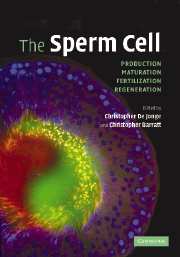Book contents
- Frontmatter
- Contents
- Preface
- List of contributors
- 1 Mammalian spermatogenesis and sperm structure: anatomical and compartmental analysis
- 2 Sperm chromatin stability and susceptibility to damage in relation to its structure
- 3 Genomic and proteomic approaches to defining sperm production and function
- 4 Sperm maturation in the human epididymis
- 5 Controls of sperm motility
- 6 Regulation of capacitation
- 7 Reactive oxygen species: friend or foe
- 8 Testing sperm manufacturing quality: the sperm–zona binding assay
- 9 Genetics: a basic science perspective
- 10 Sex chromosome abnormalities and male infertility: a clinical perspective
- 11 Epigenetic patterning in male germ cells: importance of DNA methylation to progeny outcome
- 12 The DAZ gene family and human germ cell development from embryonic stem cells
- Index
12 - The DAZ gene family and human germ cell development from embryonic stem cells
Published online by Cambridge University Press: 14 August 2009
- Frontmatter
- Contents
- Preface
- List of contributors
- 1 Mammalian spermatogenesis and sperm structure: anatomical and compartmental analysis
- 2 Sperm chromatin stability and susceptibility to damage in relation to its structure
- 3 Genomic and proteomic approaches to defining sperm production and function
- 4 Sperm maturation in the human epididymis
- 5 Controls of sperm motility
- 6 Regulation of capacitation
- 7 Reactive oxygen species: friend or foe
- 8 Testing sperm manufacturing quality: the sperm–zona binding assay
- 9 Genetics: a basic science perspective
- 10 Sex chromosome abnormalities and male infertility: a clinical perspective
- 11 Epigenetic patterning in male germ cells: importance of DNA methylation to progeny outcome
- 12 The DAZ gene family and human germ cell development from embryonic stem cells
- Index
Summary
Introduction
Ten to fifteen percent of couples are infertile (Hull et al., 1985). Yet, very little is known of the genetics of infertility in men or women. Given the heavy reliance upon technology in Western countries to bypass germ cell defects, it is timely that we begin to understand the genetics of infertility and the outcomes to the reproductive and somatic development of children that are conceived. Here we discuss studies that led to a greater understanding of one gene family implicated in human germ cell development, the DAZ (Deleted in AZoospermia) gene family and then review findings of experiments aimed at establishing an in vitro genetic system to study human germ cell formation and early differentiation. These studies provide the framework for building the genetic tools that are required to probe the functional genetics of germ cell development in men and women. With time, we expect that the availability of a system to assay the complex functions of human genes and gene variants in vitro will result in increased ability to design rational therapeutics for germ cell defects, to accurately assess outcomes of infertility treatments, to minimize risks associated with use of assisted reproduction and to develop useful genetic tests to aid infertile couples.
Specification of the germ cell lineage in vivo in model organisms
Two divergent developmental programs are associated with specification of the germ cell lineage in model organisms.
- Type
- Chapter
- Information
- The Sperm CellProduction, Maturation, Fertilization, Regeneration, pp. 323 - 350Publisher: Cambridge University PressPrint publication year: 2006



